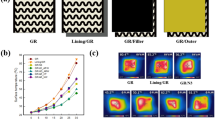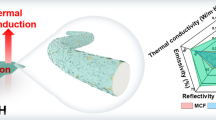Abstract
The objective of this study was to determine effects of relative humidity on electrical heating textile properties. Relative humidity (RH) is a factor to determine clothing comfort. Electrical heating textile is used in close contact with human skin in winter or under extreme environments. Graphene/polymer composite was coated with flame retardant cotton fabric with a horseshoe-pattern. The relative humidity was controlled through water-sulfuric acid method. Samples were stored in external environment with different RH (25-% RH, 35-% RH, 45-% RH, 55-% RH, 65-% RH, and 90-% RH). With increasing RH, weight change rate also tended to increase due to increase amount of moisture absorbed by cotton fabric. Regarding surface resistivity under dry and each RH condition, it was found that surface resistivity change rate tended to decrease from 25% RH to 55% RH and then started increasing upto 90 % RH. Surface temperature and current of samples with various RH conditions were linearly increased with increasing applied voltage. When a voltage between 5 V and 6 V was applied to samples with various RH conditions, surface temperature was about 50 °C. Differences in surface temperature and current change rate tended to increase from under 25 % RH to 55 % RH conditions. However, they started decreasing from 65 % RH condition and the decline continued upto 90 % RH condition. These results confirmed that 55 % RH condition could improve electrical and electrical heating properties of samples. This condition could be expected to improve electrical properties of electrical heating textiles for wearable electronic applications.
Similar content being viewed by others
References
G. S. Cho, “Clothing and Environment”, 1st ed., pp.3–40, Dongseomunhwawon, Seoul, Korea, 2009.
G. Song, “Improving Comfort in Clothing”, 1st ed., pp.3–56, Woodhead Publishing, Cambridge, United Kingdom, 2011.
M. A. Taylor, “Technology of Textile Properties”, 3rd ed., pp.12–19, Forbes Publications Limited, London, United Kingdom, 1991.
R. A. Angelova in “Occupational Health”, 1st ed. (O. Korhan), Chap.11, pp.223–236, IntechOpen, London, United Kingdom, 2017.
C. Zhang, C. Ren, Y. Li, W. Song, P. Xu, and F. Wang, Text. Res. J., 87, 1251 (2017).
W. F. Song, C. J. Zhang, D. D. Lai, F. M. Wang, and K. Kuklane, Sci. Rep., 6, 19326 (2016).
L. R. Pahalagedara, I. W. Siriwardane, N. D. Tissera, R. N. Wijesena, and K. M. N. de Silva, RSC Adv., 7, 19174 (2017).
C. Hertleer, A. V. Laere, H. Rogier, and L. V. Langenhove, Text. Res. J., 80, 177 (2010).
M. D. Husain, O. Atalay, and R. Kennon, Int. J. Text. Sci., 2, 105 (2013).
C. Melios, A. Centeno, A. Zurutuza, V. Panchal, C. E. Giusca, S. Spencer, S. R. P. Silva, and O. Kazakova, Carbon, 103, 273 (2016).
A. Benchirouf, S. Palaniyappan, R. Ramalingame, R. Raghunandan, T. Jagemann, C. Műller, M. Hietschold, and O. Kanoun, Sens. Actuators. B. Chem., 224, 344 (2016).
G. Rosace, V. Trovato, C. Colleoni, M. Caldara, V. Re, M. Brucale, E. Piperopoulos, E. Mastronardo, C. Milone, G. D. Luca, and M. R. Plutino, Sens. Actuators. B. Chem., 252, 428 (2017).
P. Cataldi, L. Ceseracciu, A. Athanassiou, and I. S. Bayer., ACS Appl. Mater. Interfaces, 9, 13825 (2017).
M. Tian, Y. Huang, W. Wang, R. Li, P. Liu, C. Liu, and Y. Zhang, J. Mater. Res., 29, 1288 (2014).
A. Qadir, Y. W. Sun, W. Liu, P. G. Oppenheimer, Y. Xu, C. J. Humphreys, and D. J. Dunstan., Phys. Rev. B. 99, 045402 (2019).
H. Kim and S. Lee, Fash. Text., 5, 7 (2018).
H. Kim and S. Lee, Text. Sci. Eng., 54, 315 (2017).
H. Kim, S. Lee, and H. Kim, Sci. Rep., 9, 1151 (2019).
H. Kim and S. Lee, Text. Res. J., 89, 4114 (2019).
H. Kim and S. Lee, Polymers, 11, 928 (2019).
Acknowledgements
This research was funded by Basic Science Research Program through the National Research of Korea (NRF) funded by the Ministry of Science, ICT and Future Planning (NRF-2016M3A7B4910552).
Author information
Authors and Affiliations
Corresponding author
Rights and permissions
About this article
Cite this article
Kim, H., Lee, S. Effect of Relative Humidity Condition on Electrical Heating Textile Coated with Graphene-based on Cotton Fabric. Fibers Polym 22, 276–284 (2021). https://doi.org/10.1007/s12221-021-9820-8
Received:
Revised:
Accepted:
Published:
Issue Date:
DOI: https://doi.org/10.1007/s12221-021-9820-8




